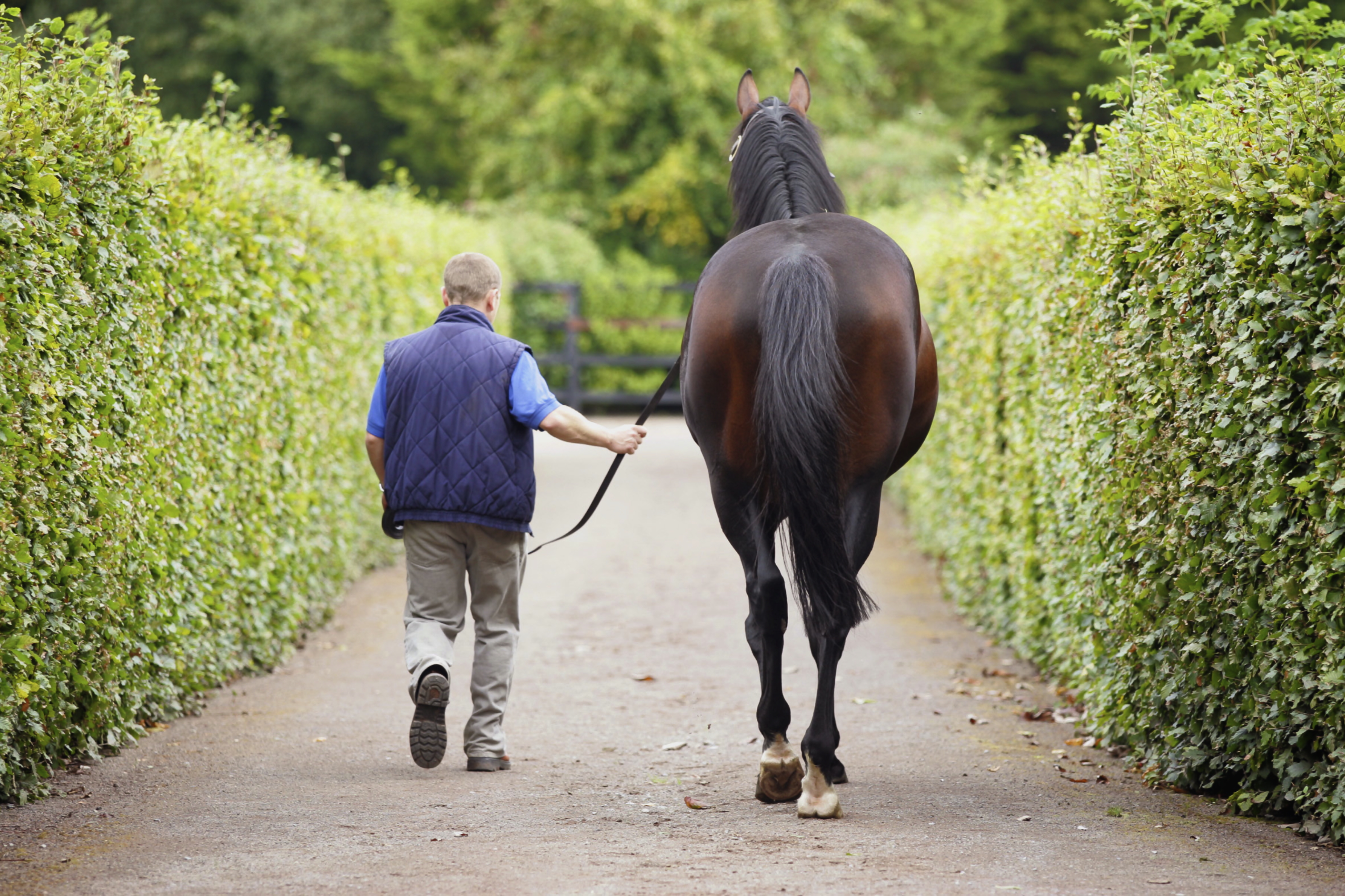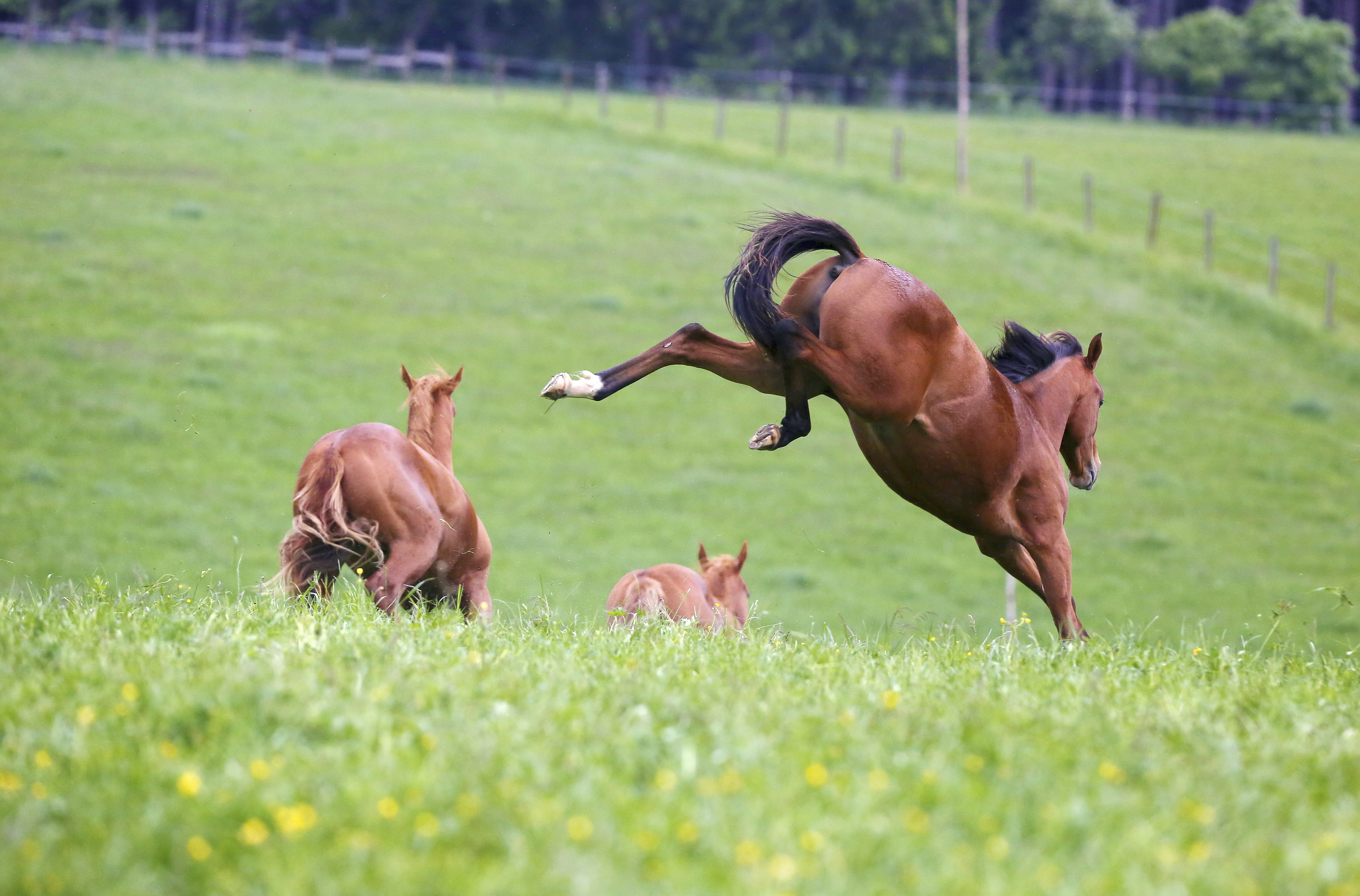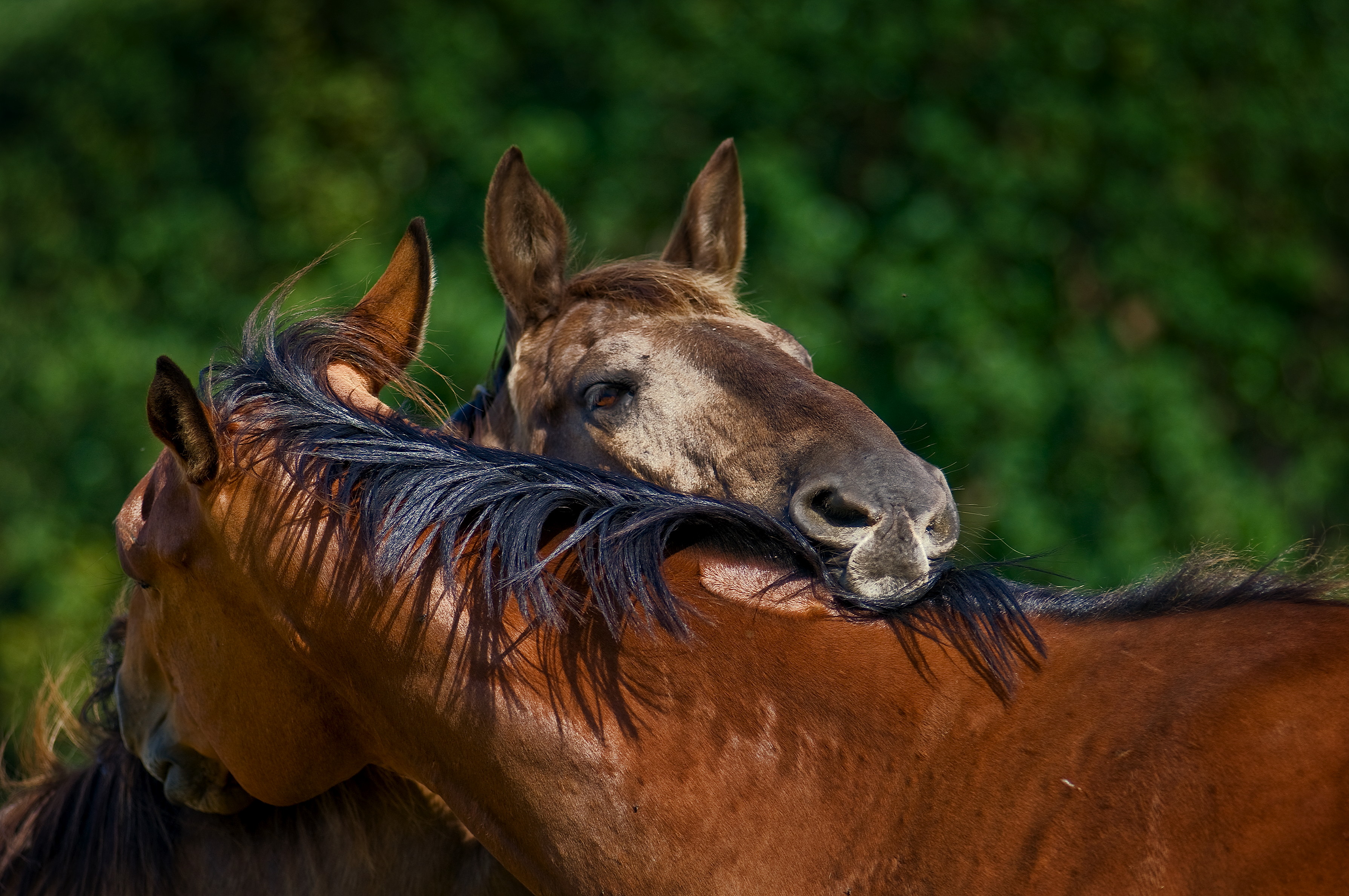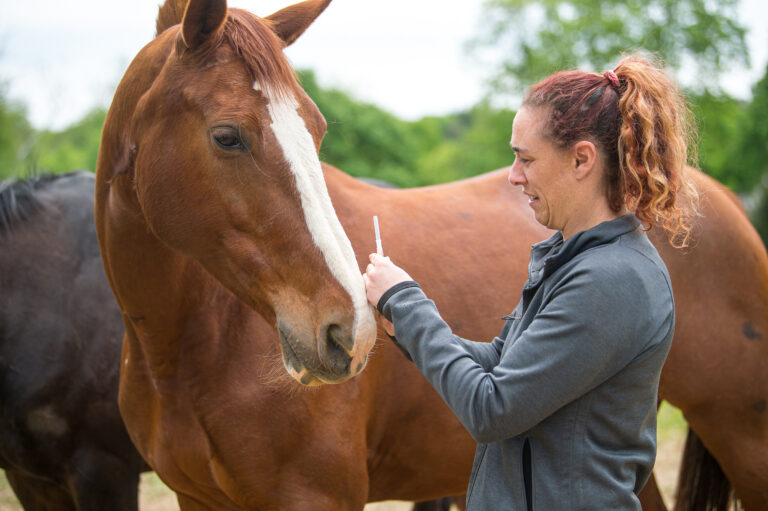
A raw day with a dark sky threatening rain. You’ve decided to skip your ride and you’re staying out of the weather. So is your horse, snug in his stall with a big pile of hay. But maybe that’s not the best place for him.
As an Amazon Associate, Practical Horseman may earn an affiliate commission when you buy through links on our site. Product links are selected by Practical Horseman editors.
We asked three experienced horse keepers to share their views on the pros and cons of keeping horses in stalls or out in the field. Spoiler alert—although their programs vary, they all want their horses outside as much as possible, even in weather that would keep you indoors. Here, they explain why and offer some tips on finding the right balance of barn time and field time for your horse.

Turn Him Loose
“Stabling is more a human thing than a horse thing,” says Karyn Malinowski, PhD, professor of animal sciences and founding director of the Rutgers Equine Science Center in New Brunswick, New Jersey. “Too often horses work and then spend the rest of their time in a stall. The schedule is really for the convenience of owners, trainers and riders.”
The Rutgers center’s research horses live outdoors year-round in fields and paddocks with run-in sheds. “They are outside unless they are brought in for a reason,” Dr. Malinowski says. “Being outside helps them stay happy and healthy.” That makes sense—after all, horses evolved living in groups and constantly roaming over wide areas, often traveling 10 miles or more a day to graze.
But round-the-clock turnout may not suit every situation in today’s horse world. Camie Heleski, senior lecturer with the University of Kentucky’s Equine Science and Management program, currently has her own two horses pastured 24/7. “I think their mental well-being is perhaps the best it’s ever been,” she says. “But they are a little overweight, their coats are sun-faded and they have slightly chipped hooves.” Because it’s hard to keep horses in perfect body and coat condition when they live out all the time, she acknowledges, that may not be the best option for show horses.
In the past, when Camie showed her horses, they were in the pasture 12 hours a day and in box stalls the other 12. “During winter, they stayed in at night and in the warm months they stayed in during the day,” she says. “For night turnout, I used a fly spray designed to deal with mosquitoes as well as flies.” The split schedule also allowed the horses to get roughly half their diet on an individual basis and made it easier to administer supplements or medications.
At John and Beth Manning’s lesson and boarding barn, Biscuit Hill Farm in Shelburne, Massachusetts, horses are out all day and stalled for the night. “We don’t think living out all the time is good,” Beth says. “We empty the barn in the morning every day of the year except Christmas and New Year’s Day, and the horses come back in for dinner.” The horses wear fly masks in summer and waterproof turnouts in wet or cold weather.
The daily schedule provides a built-in opportunity to inspect each horse. “When horses live out all the time, it’s easy to miss health problems. When you lead a horse in, you will look at him and notice if something’s not right,” Beth says. Because the farm (true to its name) is on a hill, she says the horses build fitness as they move around their paddocks. All-day turnout also helps older horses stay limber, countering the effects of chronic arthritis, and it promotes hoof health. “Nearly all our school horses can go barefoot because they’re out so much,” she says, “and because our horses are not cooped up, we have few behavior problems.”

But What About …
Research supports the positive effects of extensive turnout. Various studies link pasture time to benefits ranging from stronger bones, better respiratory health and reduced colic risk to lower stress levels and improved trainability. Are there downsides? No question—but in most cases, they’re manageable. These are the main worries:
Risk of injury: Horses can get hurt frolicking in the pasture, but the experts we talked to say horses that are out consistently generally learn to take care of themselves. For one thing, they’re less likely to explode with pent-up energy than are horses who are stalled most of the time. Making sure that turnout areas are safely and securely fenced and free of debris, holes and other hazards will go a long way to minimizing injury risks. Barefoot horses are less likely to slip on snow-covered or frozen ground, Beth says; otherwise, horses need winter shoes with studs or borium for grip in those conditions.
Weather: You may think it’s too cold or too wet to be outside, but your horse can deal with a much wider range of weather conditions than you can. “There’s no normal weather condition in which a horse needs to be inside,” Dr. Malinowski says. At Biscuit Hill, horses go out in rain, snow and every kind of weather except lightning and extreme conditions like a blizzard. “In the hottest weather we may shorten the time out and bring the horses in early,” Beth says. Individual horses may need special consideration, of course. “If horses are very young, very old, unhealthy, very thin, with very little hair coat–all those factors influence their ability to handle cold weather,” Camie says.
A little effort can overcome other less serious turnout concerns, she adds. Among them:
Lost shoes: A horse is much more likely to throw a shoe in the field than in his stall. But staying on top of his shoeing schedule can help keep shoes on. So can bell boots. (The problem is solved, of course, if the horse can go barefoot.)
Pesky insects: Fly masks, fly sprays and good farm management can help keep biting bugs at bay, although a horse with a bona fide insect allergy may still need to stay in during hours when the pests are most active.
Inconvenience: Your horse won’t be waiting in the barn when you show up to ride, but whether that’s a bad thing may depend on your point of view. “My horses’ pasture is about 40 acres, so it’s often a long walk to get them—good exercise for me,” Camie says.
Beth says the benefits of turning horses out far outweigh the risks. “Yes, the horses get dirty. But I will take a dirty, happy horse over one that’s clean but cooped up every time,” she says.

Alone or With His Buddies?
Research suggests that horses benefit most from being outside when they go out in groups. That’s largely because group turnout gives horses a chance to fill their need for social contact with others of their kind, explains Camie. “Enhanced social interaction [including the opportunity for mutual grooming] is a highly valued, highly motivated behavior for horses,” she says. “Horses out in groups are likely to exercise more than horses in individual turnout. A few studies have shown these horses to be easier to train and handle.” Stereotypic behaviors such as weaving and stall-walking are less common among these horses, too.
There are caveats. “Horses love to be out with buddies, but there’s a risk of aggression when they’re first put together,” Dr. Malinowski notes. “You have to watch when introducing new horses to a group. Use common sense and turn out in groups that are compatible in age, sex and activity levels.” Cross-fencing (dividing a large pasture into smaller sections) allows horses to graze individually or in compatible groups. It also allows horses that are sick, injured or disabled to be separated from the larger group and it eases the introduction of new horses.
While most of the Biscuit Hill horses go out in groups, Beth says she will not turn a horse with hind shoes out with others because of the risk of serious kick injuries. But like the other experts we talked to, she says that horses usually settle the pecking order quickly when they’re put together. Once that happens there are few problems, but horses that continue to harass each other should be separated.
Established group dynamics sometimes change with time, Dr. Malinowski notes. She says that Lord Nelson, the former Rutgers campus patrol horse and resident equine personality who died in 2015 at age 42, happily shared a paddock for years with a mare. “They were best buddies, but as he became weaker with age she became more aggressive,” she says. The two had to be separated.
Horses that rank low in the group may lose condition if dominant individuals push them away from food, water and shelter in the field. Providing multiple hay racks and water sources can help prevent this, but horses may need to be separated at feeding time to make sure they all get their fair share. Low rank can have other repercussions, Camie notes. She had a mare who was submissive to most of the other horses in her group and would not lie down in the pasture apparently because of that. “If she was out 24/7 she seemed to get crabby and I always assumed it was because she had no opportunity for deep sleep,” Camie says. The mare had to come in to a stall to rest.
“Anecdotally, people will say that individual turnout is safer for the horses, with less chance of injury,” Camie says, “and certainly if the group housing involves frequent changes in population, that is likely true.” Horses that live out in groups can also become herd-bound—anxious about being separated from their pals—to the point that taking just one horse on a trail ride or to a show becomes difficult, she says. Individual turnout avoids that problem.

Time Indoors
Sometimes it’s necessary to keep a horse in. Maybe he’s stabled for weeks at a show venue where there’s little or no chance for turnout or maybe he’s grounded by illness or lameness. For example, a tendon injury will likely call for a period of stall rest followed by strictly limited exercise. While a day in won’t bother most horses, weeks or months with little or no turnout are something else.
“Horses get used to being in, but there are health risks,” says Dr. Malinowski. You may worry about turnout injuries, but a barn can be a hazardous place for a horse. Dust and poor ventilation contribute to airway disease, and research shows that confinement in a stall reduces gut motility, increasing colic risk. In addition, stall life can be isolating and stressful for herd animals like horses. That stress contributes to stall-walking, weaving, repetitive pawing and other stable vices as well as a range of health problems. If your horse must stay in, take steps to minimize the risks:
- Put him in a stall where he can see, hear and, if possible, touch noses with compatible horses. “Horses need to see each other,” Dr. Malinowski says.
- Get him out and moving daily or, better, several times a day. Unless he has a health condition that prevents it, exercise is a must.
- Provide plenty of hay and stall toys (if he’ll use them) to keep him occupied. If he’s on the chubby side, you can put the hay in a slow-feeding net that makes him work a little harder to get it.
- Keep the dust down. Open barn windows for ventilation, don’t use straw for bedding (it’s dusty) and store hay in a separate building. Soaking or steaming hay before feeding will further reduce dust.
A horse that’s been stabled for much of his time may be stressed by turnout at first. “Novelty of any kind is stressful to horses,” Dr. Malinowski says. Horses laid up from the racetrack, she notes, may take a month or more to fully relax outside and drop their heads to graze for extended periods. It’s a good idea to gradually ease horses like this into turnout and to keep an eye on them at first. “In the long run, they are happier and healthier out,” she says.
Essentials for Outdoor Living

To stay happy and healthy out in the field, your horse needs these basics:
Water. “Access to water is essential, so we have automatic waterers,” Biscuit Hill’s Beth Manning says. If your property has a stream that flows year-round (and isn’t polluted) that may suffice; otherwise, you’ll need to provide and maintain stock tanks or waterers in each field and paddock.
Shelter. Horses need access to shelter—protection from rain, winter wind and summer sun—but it doesn’t have to be fancy, Dr. Karyn Malinowski says. Run-in sheds are great, but a line of trees can break the wind, provide shade and also shelter from showers. Horses sometimes use shelter less than you might think, she adds: “Our research horses will stand out in the rain even though they could go in the sheds if they chose.”
Munchies. Horses are grazers, and they need forage to chew on pretty much all the time. Forage helps their digestive systems function properly and it staves off boredom and restlessness.
Maintenance. “The more horses are out, the more it’s important to rotate pastures, monitor for parasite risks and stay on top of other management chores,” Beth says. Pastures need to be mowed, dragged and occasionally reseeded. Manure needs to be scooped from paddocks. To make up for that, you’ll have less stall cleaning.
This article was originally published in the October 2017 issue of Practical Horseman.












